Washington Teasdale, 1830 - 1903
by Brian Stevenson
Last updated October, 2019
Washington Teasdale is best remembered today for his microscopic engravings on glass slides, consisting of elliptical spirals and other geometric shapes (Figures 1-5). As discussed further below, the concentric pattern slides were produced by a diamond blade attached to a pair of pendulums, which acted in opposition to each other (a “harmonograph”). Teasdale’s micro-rulings were described by Brian Bracegirdle in Microscopical Mounts and Mounters as, “ruled over an area of about 6 mm square, very finely (to the extent that it can be difficult to find anything on them!), and are uncovered. They are now collector’s items”.
Teasdale’s life was a mixture of tragedy and good fortune. His father died when Washington was only 6 years old. He, his mother, and two siblings were taken in by his maternal grandfather, who had become very wealthy from a plumbing and glazing business. That income allowed the family to move from the congestion of Leeds, Yorkshire, to a large house in the countryside. It also provided Teasdale with an education in civil engineering, which led him to India to work on the subcontinent’s railway system. His fiancée soon joined him, and they married in Bombay. But, within a year, she gave birth to twins - a girl and a stillborn boy - then died two weeks later. The daughter died before her 2nd birthday. Returning to England several years later, Washington Teasdale inherited his grandfather’s estate. He did not remarry, nor work again, but instead dedicated his time to scientific endeavors. He was a Fellow of the Royal Microscopical Society and the Royal Astronomical Society, and a member of numerous local scientific and other organizations.
Circa 1876, Teasdale designed a wooden-framed simple microscope, which was then manufactured and sold by Field, of Birmingham (Figure 6). He described it as a “field naturalist’s microscope”, although it is far too cumbersome to pack into the field, and is best suited for work on a desk at home. Teasdale wrote, “It was termed a 'Field Naturalist' rather than a 'Dissecting' Microscope to disarm the suspicion with which some people look upon an instrument with the latter name as a rack or means of torture for frogs, &c".
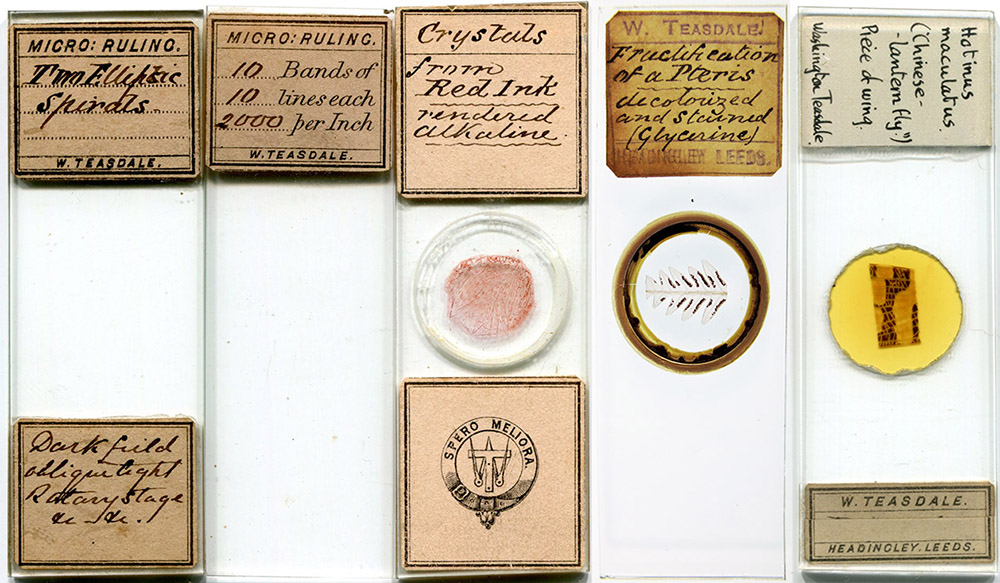
Figure 1.
Microscope slides by Washington Teasdale. The two on the left are uncovered micro-engravings, while the other three are more typical preparations. The slide on the far right was once owned by David S. Spence (1895-1975), who tended to replace original descriptive labels with his own (top label), while also retaining identification of the slide's maker. From the author’s collection or adapted for nonprofit, educational purposes from an internet auction site.

Figure 2.
Image of a ca. 1878 Teasdale spiral ruling, evidently produced by use of a two-pendulum harmonograph (Figure 3). The specimen was photographed through a 3.5x objective lens with phase contrast illumination.
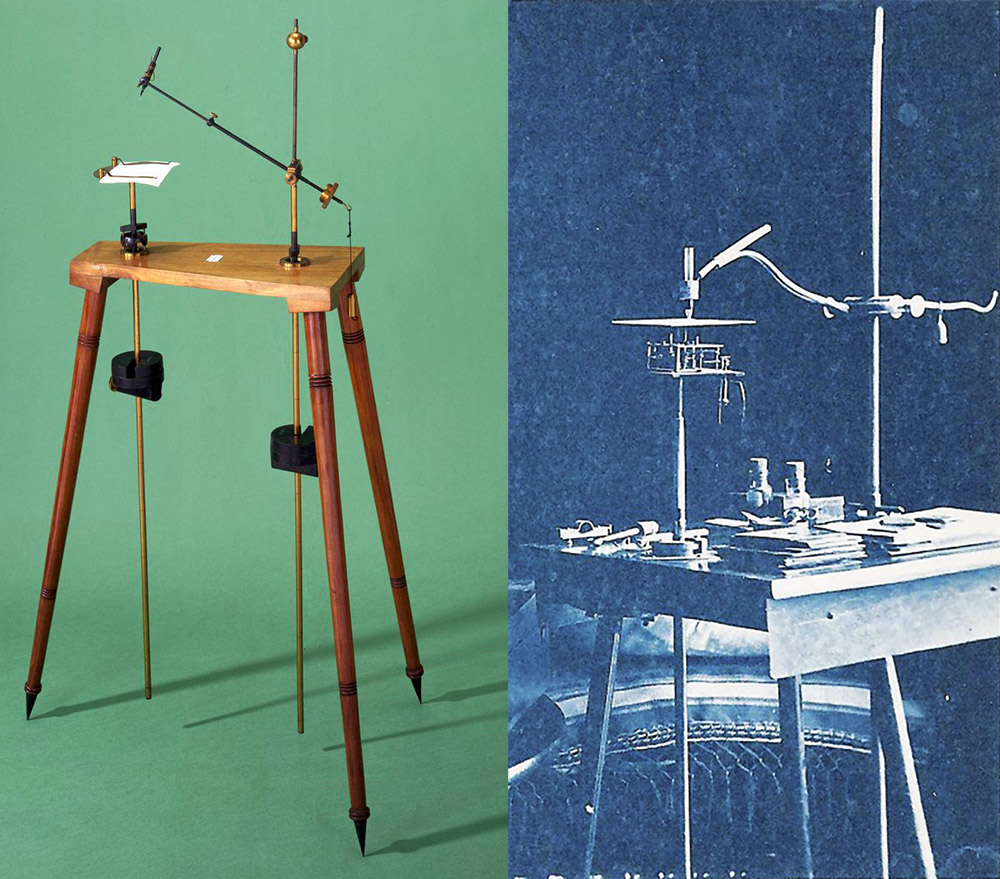
Figure 3.
Left, A Harmonograph, manufactured by Newton & Co., London, ca. 1902. The tripod table holds two freely-moving pendulums. To the top of one pendulum is affixed a piece of paper, and a pen/pencil is attached to an arm on the other pendulum. Putting pen to paper, setting the two pendulums in motion results in a trace of the combination of both motions. Each pendulum has an adjustable weight, which regulates the rate of that pendulum’s swing.
Right, A cyanotype photograph of Teasdale’s harmonograph, taken by Teasdale. In this case, the “pen” was a diamond stylus, working against a glass microscope slide. Images adapted for nonprofit, educational purposes from https://collection.sciencemuseumgroup.org.uk/objects/co60159/harmonograph-by-newton-1909-harmonograph and http://www.mhs.ox.ac.uk/collections/imu-search-page/record-details/?TitInventoryNo=60866 .
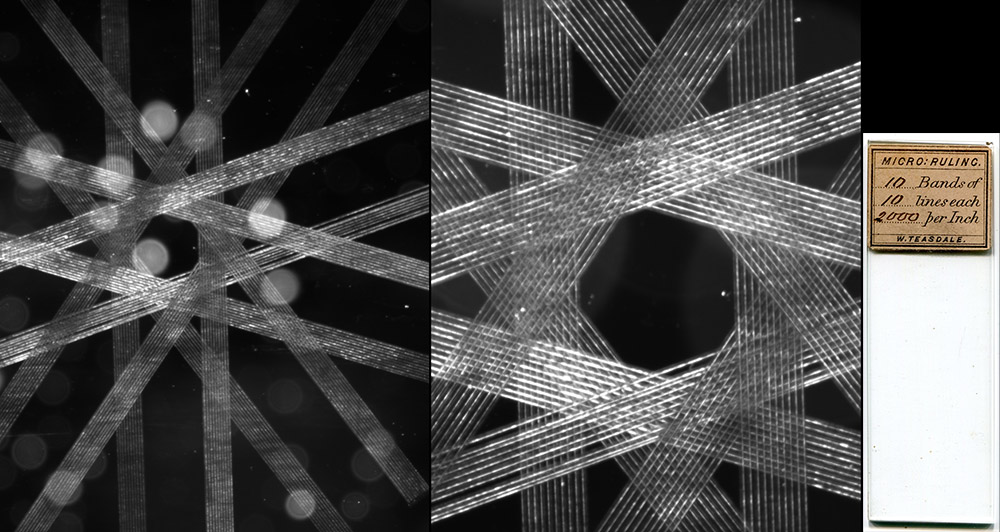
Figure 4.
ca. 1884 micro-engraving of ten sets of parallel lines, imaged while using a 3.5x and an 10x objective lens (left and center, respectively), and darkfield illumination. Henry Slack wrote in 1884, “Mr. Washington Teasdale devised an excellent test slide, helping us in these matters. One he kindly ruled for the writer consists of ten groups of parallel lines, at the rate of 2,000 per inch, disposed in a symmetric pattern of eccentric radials. The lines are ruled with a conchoidal fracture, and not a clear cut, so as to give a maximum of brilliance. This slide is to be illuminated by a spot-lens, or dark ground arrangement of condenser. If the light is exactly centred, all the bands are made to glow with equal lustre. Any slant of the light beams brings out those more plainly which lie at right angles to its line of incidence. Instead of spot-lens, or condenser, obtain a dark ground illumination from the sub-stage mirror turned strongly on one side, and then rotate the object and note the changes that ensue”.
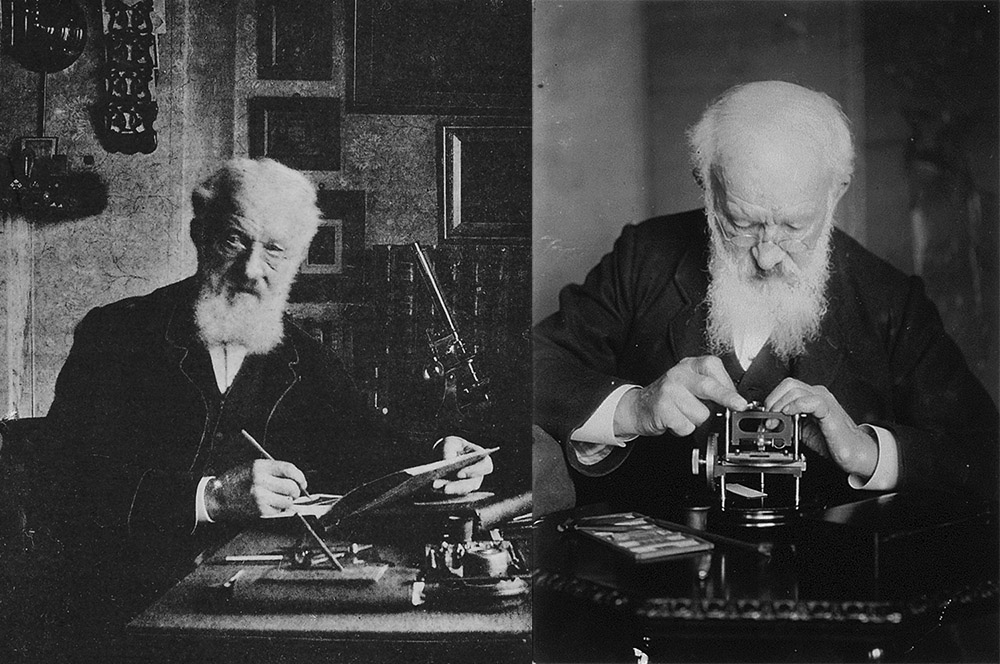
Figure 5.
ca. 1900 photographs of Washington Teasdale: Left, writing at his desk. Right, operating what is probably the micro-engraving tool used to produce the slide shown in Figure 4. Adapted for nonprofit, educational purposes from http://www.mhs.ox.ac.uk/collections/imu-search-page/record-details/?TitInventoryNo=34237 .
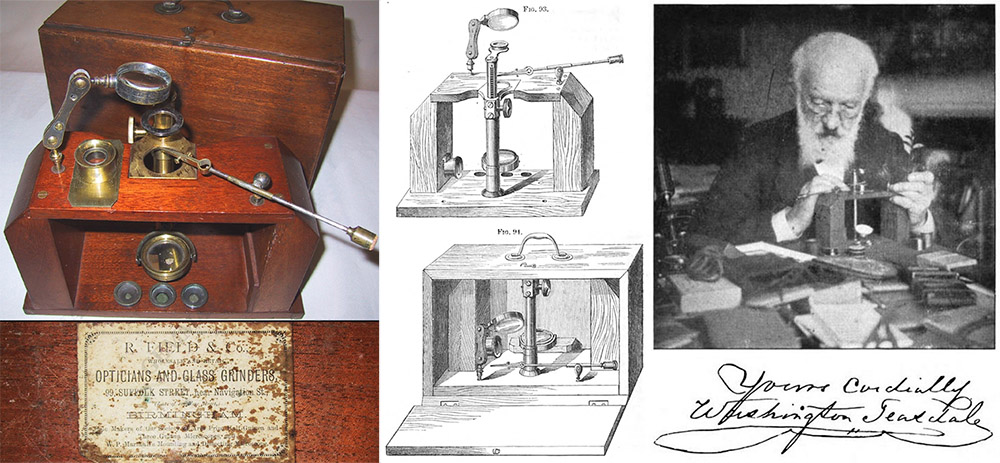
Figure 6.
Left, Teasdale’s “Field Naturalist’s Microscope”, as manufactured by Field, of Birmingham.
Center, Illustrations of the Teasdale’s design, from “The Journal of the Royal Microscopical Society”, 1882.
Right, Washington Teasdale with his “Field Naturalist’s Microscope”, from his 1903 obituary that appeared in “The Naturalist”. An 1877 review of this instrument in “The American Journal of Microscopy and Popular Science” wrote, “The Field microscope is a simple microscope with a stand sufficiently large to be firm and convenient. The lenses are evidently simple lenses … The arm which carries the lenses is moved up and down by means of a rack and pinion, and the instrument is furnished with an animalcule cage, stage forceps and bulls-eye condenser. The price of the whole is £1 5s. in deal (pine), and £1 10s. in mahogany. It must form a very cheap and convenient dissecting microscope”. The “Journal of the Royal Microscopical Society” further noted that “The lenses drop into the arm which carries them, and also into each other, so that they may be used in combination, producing seven powers in all”.

Figure 7.
Teasdale exhibited his microscope at the Special Loan Collection of Scientific Apparatus at the South Kensington Museum in 1876. This was both an exhibition and trade fair, with numerous manufacturers showing off their wares.
Washington Teasdale was born on August 8, 1830, in Leeds, Yorkshire. He was the first child, followed by three sisters and a brother. Two of the girls died in infancy. Father John, a traveling salesman, died in February, 1837, when only 38 years old.
The mother, Mary, took her three surviving children to the home of her widowed father, Christopher Heaps. Fortunately for the Teasdale family, the grandfather had amassed a considerable fortune with his plumbing and glazing businesses, which was compounded with successful real estate investments. By 1840, he and the Teasdales had moved to Rosehurst mansion in Headingley Hill, on the outskirts of Leeds.
By the time of the 1851 national census, Washington Teasdale was working as a “civil engineer”. While studying engineering, the young man had also become proficient in photography. In December, 1853, he made a presentation to the Leeds Photographic Society on his work with producing photographs on waxed paper. This insightful work was reprinted in The Journal of the Photographic Society of London and other publications, and widely discussed for several years afterward.
Teasdale moved to Bombay (Mumbai), India, in 1856, to help develop the country’s railway. The duration of his time in India is known from an 1894 presentation he made to the Leeds Philatelic Society, which described “India during the years 1856 to 1868, while he was resident there”.
The next year, in 1857, Teasdale’s fiancée from Leeds, Elizabeth Fretwell, joined him in Bombay. They were married on June 18, 1858, in the Bombay Cathedral. On March 22, 1859, Elizabeth gave birth to twins in the Fortress of Asseeghur. The girl was named Mary Eliza, while the boy was stillborn. Elizabeth died two weeks later from childbirth complications, on April 7.
A year later, in March, 1860, Teasdale wrote a letter to his sister that discussed the baby, “She is quite well as we had thought...She seems passing from Babyhood into little girlhood, she sits up and plays with sticks and bits of wood...no attempt at walking or even creeping about yet. She seems particularly sharp intelligently tunes quickly round when spoken to and looks inquiringly about with her large expressive blue eyes. I fancy she begins to know me at any rate”. Baby Mary Eliza was taken to England by Washington’s younger brother, John. However, she died soon after arriving, passing away on July 28, 1860.
About a year and a half later, Teasdale took leave to return to England. This marked the beginning of his interest in microscopy. Teasdale later wrote, “Early in 1862, being on sick leave from India, I took up in real earnest the study of microscopic objects, and, as a preliminary, made myself acquainted with all the kinds of microscopes and accessory apparatus then made and available for purchase, which information I mainly got from Dr. Carpenter's book. It took me exactly a fortnight's hard incessant work to master the whole contents of the book - rising early and working late - but I never regret those memorable 14 days. The first practical question I had to decide was, whether I should purchase a complete cheap instrument, or a first-class body and stand, worthy and capable of receiving successive additions. Happily, I chose the former, well assured that I should get something really useful and full value for my money. I bought at once the simple and compound microscopes which gained the prize and approval of the Society of Arts, land costing respectively 10s. 6d. and £3 3s. And such excellent work these instruments did for me that I still give them an honoured place among the dozen microscopes since purchased”.
Teasdale returned to India, and remained there until 1868. The 1871 census of England listed him as the head of household of Rosehurst, living with his mother, a cook and a housemaid. His occupation was recorded as “retired civil engineer”, although he was only 40 years old.
He developed his wood-framed simple microscope during the early 1870s, and began marketing it in 1876 (Figures 6 and 7). The minutes of an 1876 meeting of the West Riding Consolidated Naturalists’ Society included, “Mr. Washington Teasdale, of Leeds, exhibited the Field Naturalist's Microscope, an invention of his own, more especially for dissecting purposes, and now made for sale by the eminent firm of Field and Son, of Birmingham. The instrument is furnished with all the essential accessories of condensers, and stage forceps, rack motion, three object glasses, &c., all of which are of the best possible description. Mr. Teasdale also spoke in high terms of the cheap object glasses made by the firm of Parker and Sons, of Birmingham”.
An indication of his enthusiasm for microscopes and microscopic studies, Teasdale wrote two long and detailed essays for The English Mechanic and World of Science in 1877. Both described plusses and minuses of popular microscope stands of that time. They are reprinted in full at the end of this history.
Teasdale is best remembered for his harmonograph rulings, such as that shown in Figure 2, above. He probably began making these slides during the late 1870s - there are numerous published records of his displaying such rulers after 1878, but I have yet to find any earlier reports.
At the September 24, 1878 meeting of the Leeds Naturalists' Club And Scientific Association, “Mr. Washington Teasdale (exhibited) a new histological microscope, by Parkes of Birmingham, also specimens of microscopic ruling on glass, chiefly geometric and compound vibration curves”.
At the May 20, 1879 Conversazione of the Midland Union of Natural History Societies, “Mr. Washington Teasdale (Leeds) exhibited some very fine specimens of ruled patterns on glass”.
At the September 30, 1881, annual meeting of the Postal Microscopical Society, “The President (Mr. Washington Teasdale, F.R.M.S.) brought a very conveniently arranged Portable Microscope with Lamp and other accessories enclosed in one case, together with the following: Micro rulings on glass and steel … Sheets of various curvilinear tracery, compound vibration and geometric”.
Henry Slack’s 1884 paper on microscopic test slides included an image of a Teasdale harmonograph figure (Figure 8).
Teasdale’s enthusiasm for pendulum-inscribed figures came from earlier investigators of these phenomena, such as Jules Lissajous (1822-1880) and Franz Melde (1832-1901). The pendulums of a harmonograph can be swung at various angles to each other, and at different frequencies (adjusted by changing the position of the weight on the pendulum). Pendulum frequencies can be likened to sound frequencies, so the trace of paired pendulums can be viewed as representing a two-note combination in music (hence the name for the device, the “harmonograph”). Teasdale wrote a brief note to The English Mechanic and World of Science in 1881 on “Melde’s curves”, “That there is no English translation of Dr. Franz Melde's book on Compound Vibration Diagrams, is much to be regretted. The title is ‘Die Lehre von den Schwingungscurven’, &c., and the publisher, Johann Ambrosius Barth, of Leipzig, 1864. The illustrations are in a separate pamphlet of 11 plates, the first four of which consist of elementary diagrams, and illustrations of the earlier methods used to ascertain and indicate acoustic vibrations. The rest show initial figures of the ratios and phases of ordinary harmonic intervals from 1:1 to 1:4, as follows: Plate 5, Vibrations at an angle of 45°; Plate 6, Vibrations at an angle of 90° (Lissajous); Plate 7, Parallel vibrations; Plate 8, Lower fundamental rectilinear, and the other elliptical; Plate 9, Higher fundamental elliptical and lower one rectilinear; Plate 10, As plate 8, but the amplitude of the lower fundamental much restricted; and Plate 11, Both vibrations doubly and equally elliptic”. Plate 7 from Melde’s book is reproduced below as Figure 9. Additional illustrations of harmonograph figures are shown in Figure 10, below, reprinted from The Harmonograph. Illustrated by Designs Actually Drawn by the Machine, 1893, by H. Irwine Whitty.
The extent to which Teasdale explored the mathematics of pendulum tracings is not known, but he was clearly intrigued by the graphical illustrations of mechanical relationships. As a further example, around the turn of the twentieth century, he became intrigued with the “geometric pen”. This was a combination of gears and levers, connected to a pen. Turning a crank translated through the gears and levers to move the pen in a loop - various ratios of gears caused the pen to weave up-and-down, and back-and forth, as it completed its loops. A photograph of Teasdale with his geometric pen, and an illustration of one of his creations, are shown in Figure 11. A cyanotype by Teasdale of his geometric pen, next to his harmonograph, is shown in Figure 12.
Around 1883, Teasdale began to use a different machine to produce ruled glass slides. This device was capable of making closely-spaced, parallel grooves. Additionally, the glass slide could be rotated by a precise angle, such that crossing grooves could be inscribed (Figure 4). Figure 5 shows a photograph of Teasdale with what is likely the instrument that he used to make these slides. Henry Slack, writing in 1884, said, “Mr. Washington Teasdale devised an excellent test slide … One he kindly ruled for the writer consists of ten groups of parallel lines, at the rate of 2,000 per inch, disposed in a symmetric pattern of eccentric radials. The lines are ruled with a conchoidal fracture, and not a clear cut, so as to give a maximum of brilliance. This slide is to be illuminated by a spot-lens, or dark ground arrangement of condenser. If the light is exactly centred, all the bands are made to glow with equal lustre. Any slant of the light beams brings out those more plainly which lie at right angles to its line of incidence. Instead of spot-lens, or condenser, obtain a dark ground illumination from the sub-stage mirror turned strongly on one side, and then rotate the object and note the changes that ensue. The observer will soon find that with one illumination certain bands will appear as if on a plane above the others, but by a change in the angle of illumination, can be made to look in one below them”. The previous year, the American Monthly Microscopical Journal wrote, “Mr. Washington Teasdale, of Leeds, England, who has done some very fine work in ruling on glass, has prepared a slide for testing the illumination of a spot-lens, parabaloid, and condensers with stops. To get the best results of dark-field illumination it is necessary to have the light strike the object from all sides alike, but it is not always easy to know when the light is properly adjusted. Mr. Teasdale uses a slide ruled with bands of lines, not very closely ruled, crossing at various angles. By examining such a plate with a spot-lens or parabaloid where the light comes in from all sides the lines are all equally bright on a dark ground, but when the light is unequally adjusted some of the lines are dull or almost invisible”.
In addition to his great interests in microscopical examinations, and being a Fellow of the Royal Microscopical Society and a member of the Quekett Microscopical Club, Teasdale was a member of numerous other societies. Among these, he was a Fellow of the Royal Astronomical Society and of the Royal Meteorological Society, and member of the British Association for the Advancement of Science, Leeds Astronomical Society, the Yorkshire Naturalists’ Society, the Leeds Geological Association, the Leeds Naturalists' Club and Scientific Association, the Leeds Institute, the Leeds Photographic Society, and the Leeds Philatelic Society.
In September, 1903, Teasdale travelled to Southport, Lancashire, for the annual meeting of the British Association for the Advancement of Science. There he suffered a stroke, and passed away on Saturday, September 26. He had just passed his 73rd birthday.
Some excerpts from his obituaries provide additional insights on Teasdale’s life:
“On his return from India, then nearly 40 years of age, he entered upon the life of a cultivated man of leisure. His love for all kinds of knowledge was a passion, and it is scarcely too much to say that it would be impossible to find any subject in which he was not interested, or did not promptly take an interest when it came under his notice. … His love of science amounted to a passion. His home in Hyde Park Road was a veritable treasure house of scientific apparatus, works of art, interesting curios, and other objects that denoted the wide range of. his studies and sympathies. His collection of telescopes, cameras, microscopes, and slides is unique in its way. In every department of study which he took up he made himself acquainted with the best thinkers. He travelled hundreds of miles to meet men of light and leading in the scientific world. He had the entry to the houses of some of the most eminent scientists in London and elsewhere. Start him on a favourite topic, and he would talk by the hour, all unconscious of the claim upon the time of the ordinary man of the world. It was an amiable weakness, and men of learning were always glad to meet with a man so full of enthusiasm”.
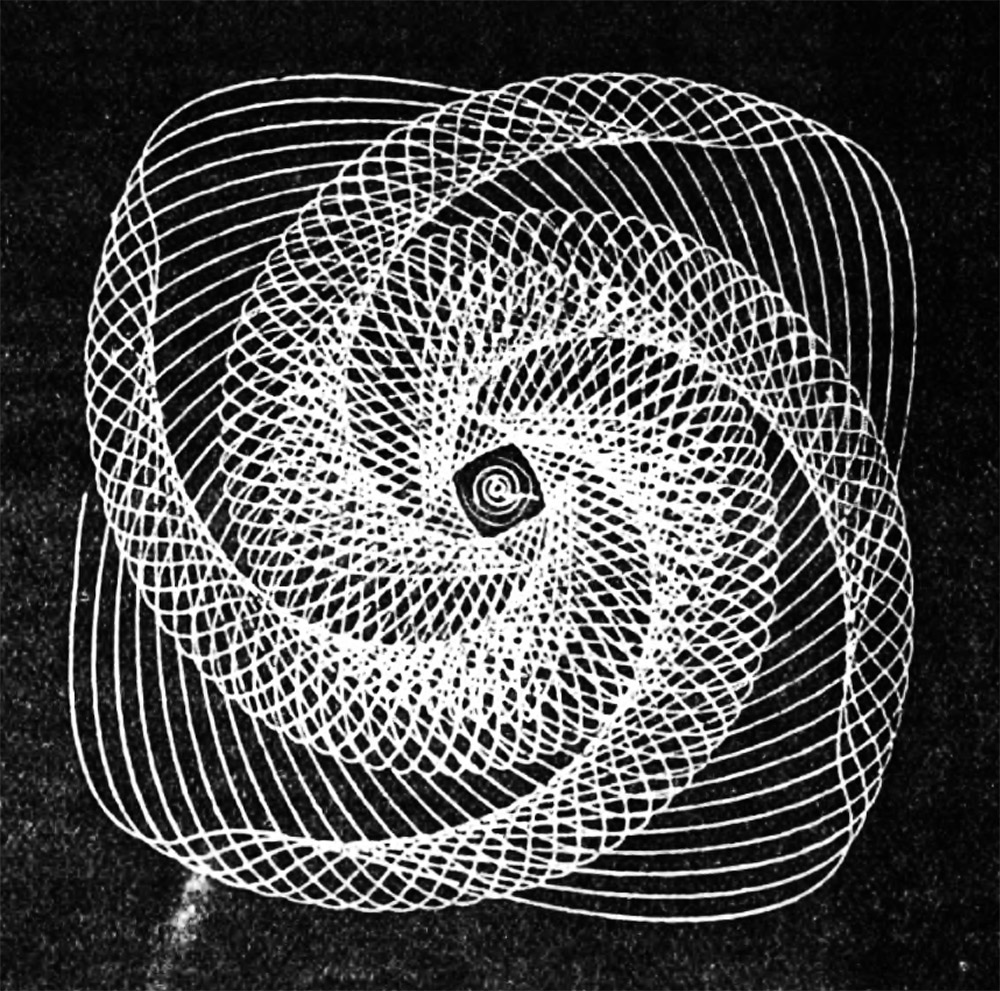
Figure 8.
A complex Teasdale harmonograph engraving for the microscope, from Henry Slack’s 1884 “Pleasant hours with the microscope”, published in “Knowledge”. Note that the image begins at the left side, then grows progressively smaller, indicative of a pendulum drawing. Production of this pattern probably used three pendulums.
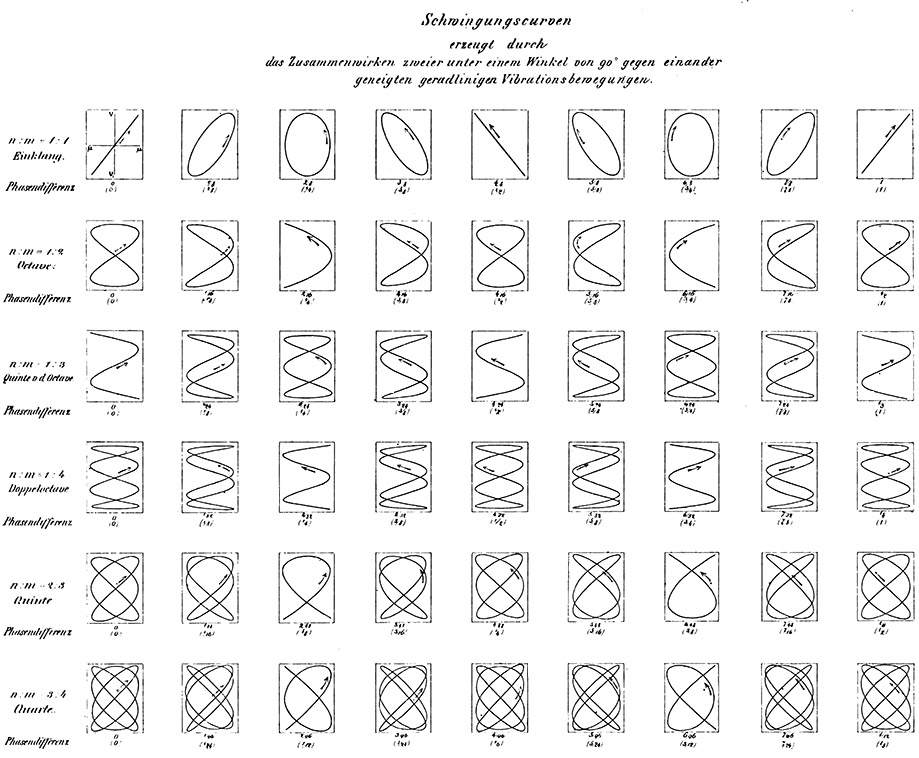
Figure 9.
Plate 7 of harmonograph tracings from Franz Melde's the appendix to “Die Lehre von den Schwingungscurven”, 1864. The tracings illustrate the effects of two pendulums that act on a single pen, at different angles to each other and at different relative frequencies. Washington Teasdale referenced Melde’s work in an 1881 letter.
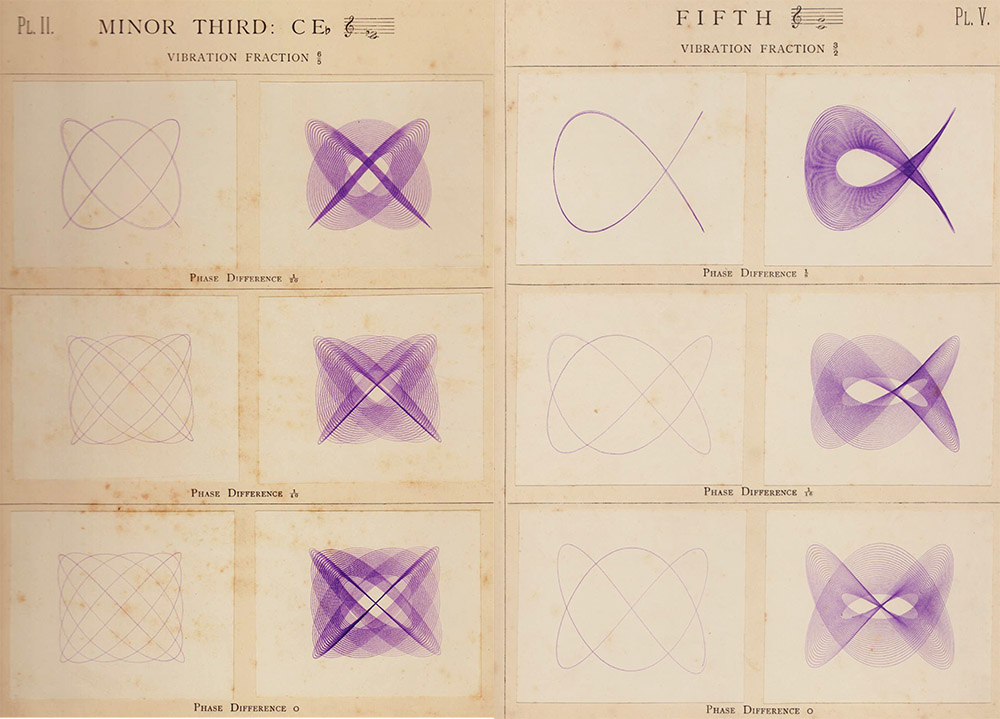
Figure 10.
Two plates of harmonograph tracings from H. Irwine Whitty’s 1893 “The Harmonograph. Illustrated by Designs Actually Drawn by the Machine”. The tracings illustrate pendulums moving at frequencies equivalent to pairs of musical notes. The differences in phases were accomplished by releasing the pendulums at different times: simultaneous release gives symmetric images, whereas delay in releasing one pendulum yields an asymmetric figure.

Figure 11.
(left) Washington Teasdale and his geometric pen,
(center) a schematic of the geometric pen’s gears and levers,
(right) examples of Teasdale’s drawings with the geometric pen. Combinations of differently-sized gears and varying lever lengths produced a multitude of designs. Unlike the harmonograph, which used pendulums that gradually slowed down and produced spiraling designs, the geometric pen produced closed loops. While one could gain insight on gear ratios from this tool, its general appeal was as a toy to produce amazing patterns. Much like today’s “Spirograph” toys. All three images are adapted from “Harmonic Vibrations and Vibration Figures”, by Joseph Goold, Charles E. Benham, Richard Kerr, and L.R. Wilberforce, 1902. This book is cited in Bracegirdle’s “Microscopical Mounts and Mounters”.
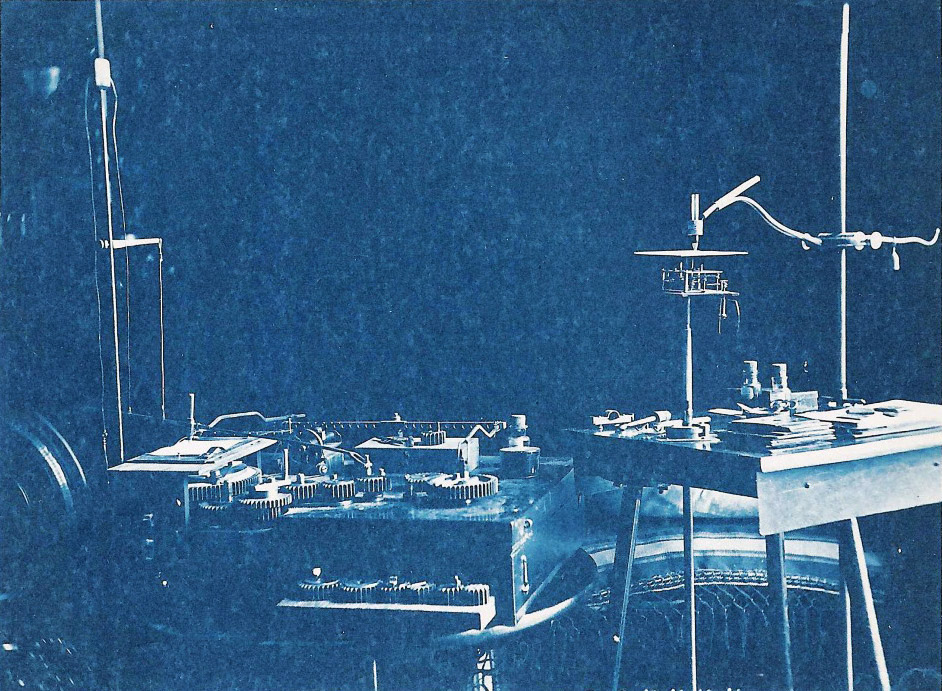
Figure 12.
A ca. 1880 cyanotype photograph by Washington Teasdale, of his geometric pen and his harmonograph. Adapted for nonprofit, educational purposes from http://www.mhs.ox.ac.uk/collections/imu-search-page/record-details/?TitInventoryNo=60866
__________________________________________
Washington Teasdale’s July 19, 1877 essay on microscopes, from The English Mechanic and World of Science:
“I have perused with much interest all the microscopic notes and correspondence which have appeared in your columns since the appearance of Mr. F.B. Kyngdom's able paper, published in your issue of January 19. He is a good man and true, and did well to state frankly his experience in the purchase of microscopes. It tempts me now sketch briefly my own, which differs widely from his, was more fortunate, and yet it has produced such results that our present opinions are nearly in accord, except in the matter of a mechanical stage, which he regards as a luxury, and I as a cumbrous obstructive nuisance.
Early in 1862, being on sick leave from India, I took up in real earnest the study of microscopic objects, and, as a preliminary, made myself acquainted with all the kinds of microscopes and accessory apparatus then made and available for purchase, which information I mainly got from Dr. Carpenter's book. It took me exactly a fortnight's hard incessant work to master the whole contents of the book - rising early and working late - but I never regret those memorable 14 days. The first practical question I had to decide was, whether I should purchase a complete cheap instrument, or a first-class body and stand, worthy and capable of receiving successive additions. Happily, I chose the former, well assured that I should get something really useful and full value for my money. I bought at once the simple and compound microscopes which gained the prize and approval of the Society of Arts, land costing respectively 10s. 6d. and £3 3s. And such excellent work these instruments did for me that I still give them an honoured place among the dozen microscopes since purchased. Experience with these enabled me fully to appreciate the extraordinary excellence combined with cheapness of the instruments of the London makers, for each and all of whom I have a profound respect, and regard them not as manufacturers or ‘shopticians’, but as scientific artists. The motto of all of them seems to be Excelsior, and they have acted up to it. Each year, notwithstanding a general rise of prices, their instruments are better, cheaper, and more convenient than ever. Not one of the old leading firms has fallen one jot from their high standard of excellence, and new men have risen in honourable rivalry and competition. With Ross I have had little to do except in the matter of photographic lenses. Powell and Lealand I principally know by high repute, and do not possess any of their work, which I rather regret, especially as their 1/8th objective is probably the best in the world, and will stand the test of deep eyepieces better than any other. Smith and Beck (now R. and J. Beck) have done good service to all microscopic observers, by condescending to make good well-finished instruments at a low price. I think their first step in concession to popularity was the ‘Educational’, price £10. It was not very cheap certainly, but it was very good - a thorough student's microscope, and is today as great a favourite and as much valued by me as it was 15 years ago. But the demand of the day was for a well-finished London made instrument for £5 (or guineas), and opticians were compelled to yield to it. Mr. Pillischer was, in some respects, the most successful, but there was a working difficulty in the matter of the triplet objective; as a 1in. and 1/2in. it worked well, but as a 1/4in. it would only work through a very thin cover. Smith and Beck's ‘Universal’ was really a remarkable and useful instrument of much optical merit. I persuaded several medical friends to purchase it, and none ever regretted doing so. ‘H. P. (H.)’ [my note: Henry Pocklington] has told you already how much be valued it, and had I known that he was about to part with his, it should have been added to my stock, for I have not one now. But in addition to the demand in 1862 for a £5 student's microscope, there was also a demand for a cheap binocular, and, in meeting this, Messrs. H. and W. Crouch were pre-eminently successful, and the position gained by them has been ably sustained to this day. I was so fortunate as to get one almost at the first, and have seen few binoculars to equal, and none to surpass it. I have not, of course, Zentmayer’s glass rotating stage, and the other improvements Mr. Crouch now supplies; but otherwise it is as perfect as a binocular could be. Of late years, the handy convenience of the small Continental model of microscope for student's work has been recognised alike by English Opticians and microscope Workers; and I am really glad that so many of our English makers now supply somewhat similar forms, for I like English mechanism and English lenses, and never could work comfortably with any foreign optical apparatus. I got Smith and Beck's ‘Economic’ (not the £5 5s. but the £6 12s. 6d. one), and enjoy working with it very much. One advantage of sticking to the microscopes of Smith and Beck and Crouch is the accurate fidelity with which they preserve their gauges for substage and other fittings. Polariser, parabaloid, spot lens, eyepiece, caps, &c, purchased more than a dozen years ago, are all available for those made today.
Among London opticians Mr. James Swift claims especial notice. His condenser (the £1 4s. one) is alike the most useful and luxurious accessory fitting that any microscope can possibly have. It came in supersession, and by way of improvement upon the Webster condenser, made by Mr. Collins, with his graduating diaphragm, which is a most efficient condenser and dark field-illuminator, but has not the polarising arrangement. Mr. Collins must be credited not only with the diaphragm but with many convenient arrangements in the way of fixings and fittings, notably the fitting of the analyser in a sliding box like the binocular prism, which, I think, he was the first to adopt.
I have great pleasure in possessing and using microscopes and accessories by all the opticians mentioned, but they are so nearly equal in excellence and cheapness that I hesitate to publicly commend one in preference to another. I do not know whether Messrs. Baker, of Holborn, are actual makers of microscopes on their own premises or not, but they procure or get them made, and are agents for all the best foreign houses, both for objectives and prepared objects. And I am well assured that there is at the head of the business a worthy microscope worker, highly respected, and for whom his customers have no ordinary regard.
The cheapest microscopes are, of course, made in Birmingham. by Messrs. Field and Messrs. J. Parkes and Son. The latter firm have wonderfully improved their work of late years, and have a large and well-conducted establishment. Their series of cheap objectives, I have no hesitation in saying, are unsurpassed, at the price, by any maker in the world.
One of your correspondents, seeking instruction, aptly remarked, that ‘in the multitude of councilors there was much confusion’. I felt sorry for him and for others, not only that there should be confusion, but that there should be so little harmony among the experienced. This acerbity of temper does not come from genial general work and enjoyment of clear low powers which Carpenter, Slack, and others have testified over and over again are best and most useful. But, from the possession of objectives above 1/4in., which, except in the hands of a few patient specialists who have at them and use them for special and exceptional work, are mere vanity and vexation of spirit, and lead their possessors to abandon for ever all reasonable microscope work, and give themselves up to seeing or imagining new patterns for gridirons and wire trellis, in little tip-cat diatoms of the Navicula class, and in trying to find out whether little round spots were pits or pimples; and, after all, the question is settled by common sense, and a comparatively low power, sufficient to show whether in a broken frustule the line of fracture is along the dots or the interspace.
It amuses me that men, who would be horrified at possible damage to their eyes if they looked steadily for five minutes at the family Bible through their grandmother’s spectacles, calmly sit evening after evening peering in vain through high objectives and deep eyepieces, and fiddle-faddle for hours with condensers and illuminators, and never seem to learn anything or get any further, but have all their imaginings upset by the revelations of diffraction gratings.
I wish, in conclusion, to record a very decided opinion, that a mechanical stage is very undesirable for general work. In the first place, it prevents a beginner from acquiring delicate dexterity of touch, or from following the motions of living objects, and it adds to the weight, complexity, and cost”.
__________________________________________
Washington Teasdale’s September 21, 1877 essay on histological microscopes, from The English Mechanic and World of Science:
“Permit me to write a short letter on three of the best English modifications of the compact student's microscope, heretofore known as the ‘Hartnack’ or ‘The Continental Model’, for which I dare suggested the name of ‘Histological’, as indicative of its special use and value. Messrs. Beck's ‘Economic’ claims prior notice. The value of the cheap student's microscope, brought out by this firm under the names of the ‘Educational’, the ‘Universal’, and ‘Economic’, has been increased by the publication of an illustrated sixpenny pamphlet, fully describing the construction, use, and varied magnifying powers of each, and its capabilities of receiving additional accessory apparatus. The price of these optional additions is generally moderate and those which fit into a tube 1 1/2in. diameter below the stage are not only available for all the instruments, but also for those of other makers, such as Mr. Crouch and Mr. Baker, who, I am glad to find, have adopted the same convenient gauge. What I object to is that all Messrs. Beck's instruments mentioned are supplied with only a concave mirror, and that, for the addition of a flat one, it has to be returned and 8s. extra paid. Moreover, their 5 guinea instruments have not a stage condenser, which ought to be part and parcel of every microscope, as it is desirable that misty objects should be looked at as well as through with all powers which admit of so doing. An efficient stage condenser is, however, supplied is an extra, at the moderate price of 5s.
The ‘Economic"’ is supplied in two forms, respectively priced £5 5s. and £6 12s. 6d., which almost necessitate separate consideration as of two distinct instruments. A 1in and a 1/4in. objective are supplied with each alike. The draw tube gives with these a graduated range of 45 to 240 diameters in the £5 5s. form, further increased to 330 diameters by the deeper e.. piece supplied with the £6 12s. 6d. form, which differs from the other in having this extra eyepiece, stage condenser, and forceps, and a rack and pinion instead of sliding adjustment to tie tube. How far a rack and pinion adjustment is advantageous or otherwise is a matter for individual consideration. I do not myself find it desirable except when using the polariser, when it prevents the analyser being turned, and as the ‘Economic’ is without a sliding tube, making the whole body removable for facile change of objectives or capable of being drawn back to suit a low power, it is so far an inconvenience. This, I find, has lately been partly remedied by lengthening the rack, but it leaves it still decidedly inferior in this one particular to those instruments like Pillischer's, which have the whole body made to slide within a tubular sheath, which sheath alone is acted upon by the rack and pinion movement. The advantage of this is so great that no movable microscope henceforth made ought to be without this novel arrangement, which possesses more advantages than I have at present time to specify.
Next in order it will be convenient to consider the histological microscopes made by Mr. J. Swift, about which my knowledge with one exceptional personal possession is limited to occasional use of several different forms belonging to my friends. General excellence in the defining power of the objectives seemed to distinguish them all. And Mr. Swift teems to have been the first to offer at a cheap rate a student's or medical microscope with powers exceeding an ordinary 1/4in., affording with the eyepiece supplied an amplitude of about 600 diameters. He has progressively altered the form of the instrument, the latest of which is called the New College Microscope, and like Beck's Economic, there are two prices. £5 5s. and £6 12s 6d., each of which have 1in. and 1/4in., objectives. The eyepieces supplied are deeper than usual, but the lenses bear the strain remarkably well. Packed in an upright case, this portable and convenient instrument, having both concave and plain mirrors, and is arranged for the addition of the most useful accessories, but these are made specially to fit it, and are not available for other microscopes. I should be glad if Mr. Swift, as well as Mr. Pillischer and other opticians, would adopt as a standard a 1 1/2in. substage tube to receive spot lens, parabaloid, polarizer, &c. I think they would be gainers in the long run, as many who now hesitate about paying a few pounds for fittings applicable only to one instrument, would readily purchase them if (like objectives) they were also available for use with most others.
In considering Mr. Pillischer's new microscope, the International, I feel that to do it justice, I must lay aside certain peculiar prejudices which arise from the possession of about half a dozen microscopes by other makers, most of whose fittings are accessories are interchangeable, and yet not one of them would be available for use with it, and, therefore, it is not of that value and use to me that would be to one who desired to have and to use only one microscope of especial convenience and utility for histological research.
The price, I find, is £7 10s., and so it does not appear to have been intended to compete with other instruments ranging from 5 to 6 1/2 guineas, but to stand alone, offered on its own merits, which are certainly considerable. Instruments of this class by other makers, at 5 guineas, have generally one eyepiece, and 1 in. and 1/4in. objectives, and no extra fittings; at 6 1/2 guineas an extra eyepiece and some desirable extras are added. The International has two eyepieces (B and C). and its two objectives are of the exceptionally high designation of 5/8th and 1/8th. The descriptive circular says these give ‘a series of eight different powers, from 50 to 420 diameters’, but as there is a draw tube to take into account, it would have been more correct to say there was a gradual range within those limits rather than eight definite steps to attain the highest. There is something in the statements of Beck's and Pillischer's circulars as to the linear amplifying power of their eyepieces and objectives, which, without both at hand, I cannot check and verify, but it seems that if Beck's 1/4in. with No. 2 eyepiece gives 330 diameters, Pillischer's 1/8th, with his C eyepiece, ought to give proportionately more than 420. Be this as it may, I know and record with pleasure, from actual observation, that Pillischer's 1/8th is a very superior lens, and not only defines excellently with its own C eyepiece, but also with a detective Kellner, forcing it up to above 1,000 diameters, and that it works with a clear space from the cover glass of about 1/10th of an inch - an advantage which few high powers which define well possess. The International has a stage condenser, good in its way, but which ought for facility of adjustment to have a universal joint instead of a rectangular one. Its telescopic sliding body, adjustable independently of the rack and pinion, which, with subordinate utility, acts upon its sheath alone, has been already alluded to as possessing important advantages. I regret the absence of a substage tube, but it could easily be added, and there is an objectionable speciality about the eyepiece which prevents it from receiving by ready adaptation accessory apparatus not specially made for it. But considered with its own special fittings alone (and without reference to the many odds and ends of single and double image prisms, tourmalines, &c), which I am wont to fit to other instruments, it is a purely histological microscope - the best I have ever seen.
As at present made and sold, both the Economic and the International have for students the great disadvantage of being packed in a flat instead of an upright case, but Messrs. Beck and Mr. Pillischer are not responsible for this, except in so far that they courteously deferred to the decision of certain professors that they should be so made, and possibly in this form they lie more conveniently upon the table of the consulting room, or the front seat of the brougham. But students travel afoot, and oftimes require to carry their microscope with them to classrooms, and to each other's houses for use and conference, and for their convenience in so doing the instruments designed for such use ought to be packed in the smallest possible upright case with as comfortable a handle at the top as can possibly be made. I know many instances in which decided preference has been given to other microscopes solely because they were so fitted.
In all the three instruments I have noticed there is room for improvement in the stage, which is provided with spring clips to press upon each end of the slide, but as these clips do not move correspondingly with motion of the slide, they are apt to catch and displace the cover glass. This difficulty is known and has long ago been provided for in other microscopes previously made by each of the makers – i.e., the double brass frame which Messrs. Beck supplied with their Educational; the single brass frame spring clipped below stage, which Mr. Swift arranged for the little Blankley which he calls the Clinical and Seaside Microscope; and the link bar movement supplied to the £5 microscope first made by Mr. Pillischer in 1862. Some such appliances or modifications thereof are as desirable now as ever they were, and if not supplied students get into the habit of dispensing with the clips altogether, and with detriment to eyesight and impairment of definition they use their microscopes in an upright position”.
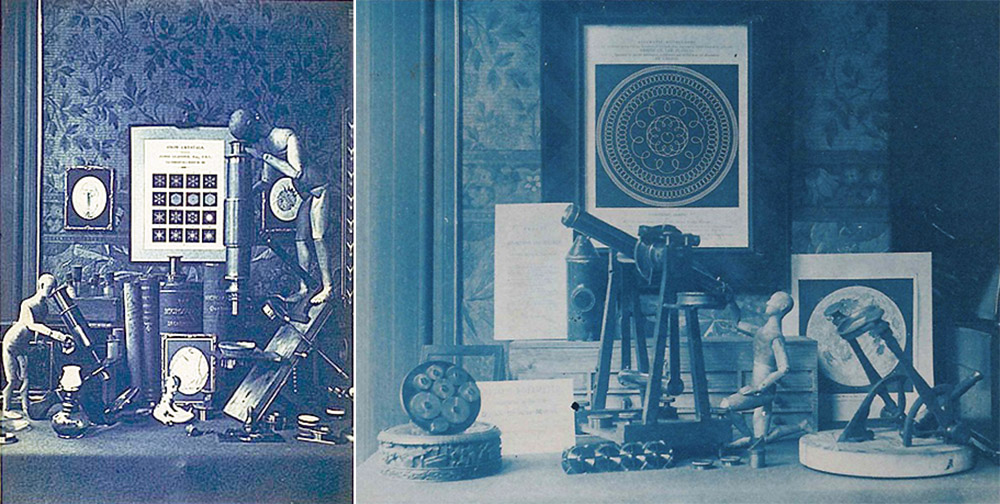
Figure 13.
Two still-life cyanotype photographs by Washington Teasdale, illustrating microscopes and related items (left) and astronomical items (right). The microscopy photograph features a “Class Microscope” by Parkes, Birmingham, and a Warrington-pattern microscope by Salmon, London. Adapted for nonprofit, educational purposes from http://www.mhs.ox.ac.uk/collections/imu-search-page/record-details/?TitInventoryNo=67947 and http://blogs.mhs.ox.ac.uk/fortheloveofit/washington-teasdales-story .
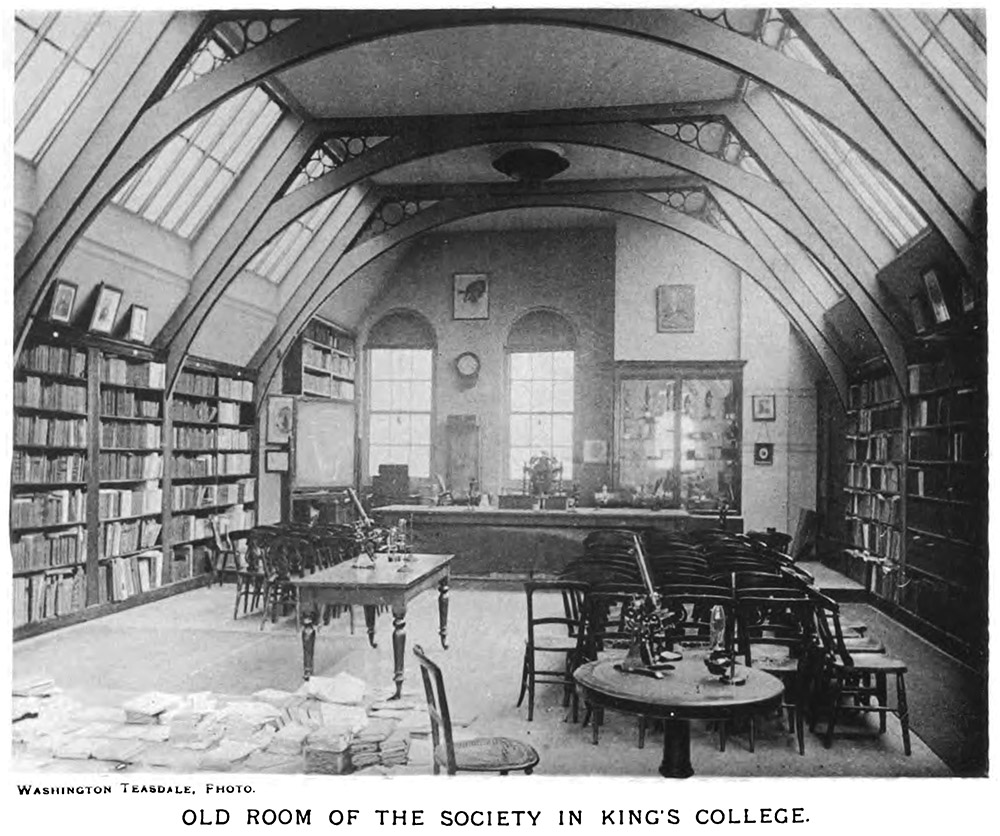
Figure 14.
Photograph of the meeting room of the Royal Microscopical Society, by Washington Teasdale.
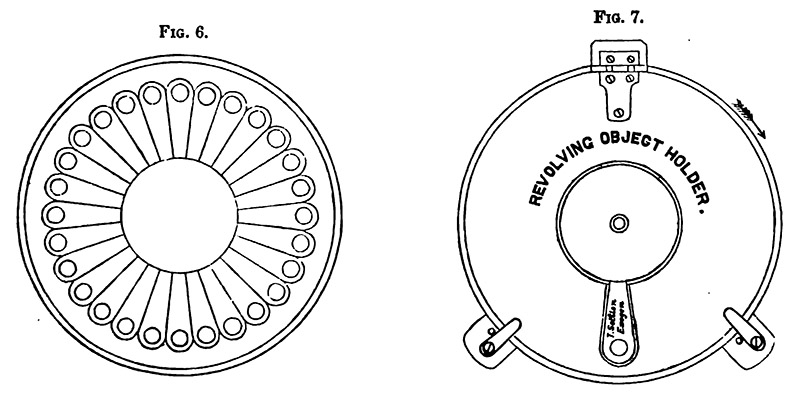
Figure 15.
Teasdale’s “Simple Revolving Object-Holder”, as described by him in the “Journal of the Royal Microscopical Society”, 1879: “The growing tendency of specialists in late years to make type slides of allied objects, induces me to suggest a mode of displaying them, which I have found very convenient for illustrating a connected series of low-power objects. The idea of a revolving object holder, although not a new one, has not hitherto been worked out in a simple and satisfactory form for general adoption. The one here described was roughly made by me and exhibited at a conversazione about three years ago. Fig. 6 represents the ‘slide’ itself, which is a disk, 6 inches in diameter, of cardboard, wood, ebonite, or other light and suitable material, pierced near its periphery with say twenty-four holes 1/2 inch in diameter; this is cemented upon another disk of equal size, of black cardboard for opaque objects and glass for transparent. To support this I use a light triangular frame, preferably of close-grained, well-seasoned wood, and fixed to the stage of the Microscope by a stiff brass clamp, furnished with a milled-head chimp screw passing through a slot, and having a circular fork to allow to pass the usual l 1/2-inch sub-stage tube of the cheaper class of instruments. As a cover to preserve the objects from dust and allow only one of them to be seen at a time, I provide another light disk, slightly smaller, say 5 1/2 inches diameter, which may be made a very neat one and of any suitable material, with an opening through which one object and its label only can be seen. Fig. 7 represents the upper view of the whole of the arrangement, the cover-disk hinged to the top of the supporting frame and held down flat by spring clips to its other extremities. These clips turn to the right when it is desired to raise and throw back the hinged cover for the purpose of changing the object-disks on the central pivot, but are prevented by a stop-pin from slipping or moving to the left when the disk is moved (in direct rotation) to bring successive objects into the field. Suitable objects for presenting thus will readily suggest themselves, say for example, sections of exogens, endogens, and acrogens; growth and development of various forms of animal and vegetable life, and comparison of all kinds of fossil organic remains with the allied forms of the present day”.
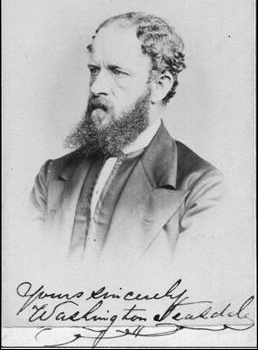
Figure 16.
Washington Teasdale in middle age. Adapted for nonprofit, educational purposes from http://fretwell.kangaweb.com.au/The Fretwells/Cawthorne/cawsevengen.htm
Acknowledgements
Thank you to Thomas Lentz for sharing photographs, and to Anita Chowdry for her engaging blog on harmonographs and for providing free access to a pdf of H. Irwine Whitty’s booklet on that topic.
Resources
The American Journal of Microscopy and Popular Science (1877) Review of Washington Teasdale’s “A Brief Paper on the Use and Educational Value of Simple Microscopes, and the Field Naturalists' Microscope in Particular”, pages 49-50
The American Monthly Microscopical Journal (1883) Note on Washington Teasdale’s rulings, Vol. 4, page 138
Bracegirdle, Brian (1998) Microscopical Mounts and Mounters, Quekett Microscopical Club, London, pages 91, 174, and 198, and Plates 35B and 47-G, H, J, and K
The British Journal of Photography (1883) Report of the Leeds Photographical Society, page 680
The British Journal of Photography (1903) Death of Mr. Washington Teasdale, Vol. 50, page 773
Catalogue of the Special Loan Collection of Scientific Apparatus at the South Kensington Museum (1876) Field Naturalist’s Microscope, Washington Teasdale, Vol. 2, pages 908-909
Chowdry, Anita (2014) Antique Harmonograph Drawings, https://anitachowdry.wordpress.com/2014/06/22/antique-harmonograph-drawings/, accessed October, 2019
England census and other records, accessed through ancestry.com
Fretwell, Leonie (accessed October, 2019) Fretwelliana: Seventh Generation, http://fretwell.kangaweb.com.au/The Fretwells/Cawthorne/cawsevengen.htm
Goold, Joseph, Charles E. Benham, Richard Kerr, and L.R. Wilberforce (ca. 1902) Harmonic Vibrations and Vibration Figures, edited by Herbert C. Newton, Newton & Co., Scientific Instrument Maker, London
Haggard, Robyn (2015) For the Love of It: Washington Teasdale, http://blogs.mhs.ox.ac.uk/fortheloveofit/tag/washington-teasesale/, accessed October, 2019
The Journal of the Quekett Microscopical Club (1904) Note on the death of Washington Teasdale, Vol. 9, page 71
Journal of the Royal Microscopical Society (1882) Teasdale's field naturalist's microscope, Series 2, Vol. 2, pages 549-551
The London Philatelist (1894) Report of the Leeds Philatelic Society, “Mr. Washington Teasdale, F.R.A.S., F.R.M.S., then gave a most interesting account of ‘Postal Administration in India during the years 1856 to 1868’, while he was resident there, illustrating his remarks by a large number of stamps on original envelopes, drawings, seals, and other objects”, Vol. 3, page 306
M. Benjamin Katz Fine Books and Rare Manuscripts (accessed October, 2019) Texts of three letter from Washington Teasdale, 1860-1865, https://www.mbenjaminkatzfinebooksraremanuscripts.com/product/4554/1860---1865-THREE-3-ORIGINAL-LETTERS-HANDWRITTEN-BY-NOTED-ENGLISH-ENGINEER-SCIENTIST-AND-PIONEERING-PHOTOGRAPHER-AS-HE-TRAVELS-AROUND-INDIA-WORKING-FOR-THE-MONUMENTAL-PROJECT-CONNECTING-BOMBAY-TO-OTHER-EAST-INDIAN-CITIES-WASHINGTON-TEASDALE
Melde, Franz (1864) Die Lehre von den Schwingungscurven, and Atlas of images, Johann A. Barth, Leipzig
Microscopical News and Northern Microscopist (1881) Report of the Seventh Annual Meeting of the Postal Microscopical Society, Vol. 1, pages 41-42
The Midland Naturalist (1879) Report of the Conversazione of the Midland Union of Natural History Societies, Vol. 2, page 171
Monthly Notices of the Royal Astronomical Society (1904) Obituary notices: Washington Teasdale, Vol. 64, p.293-294)
The Naturalist (1876) Report of the West Riding Consolidate Naturalists’ Society, pages 190-192
The Naturalist (1878) Report of the Leeds Naturalists' Club And Scientific Association, page 64
The Naturalist (1880) Reports of the Leeds Naturalists' Club And Scientific Association, pages 62 and 88
The Naturalist (1903) Washington Teasdale, 1830-1903, pages 417-418
The Observatory (1903) Washington Teasdale, Vol. 26, pages 428-429
Probate of the will of Washington Teasdale (1903) “Teasdale Washington of 255 Hyde park-road Headingley Leeds died 19 September 1903 at the ‘Scarisbrick’ hotel Southport Lancashire Probate Wakefield 2 November to John Christopher Teasdale accountant James George Chadwick cloth-merchant and Frank Kidson artist Effects £10672 8s 9d. Resworn £11069 14s 9d”, accessed through ancestry.com
Process: The Photomechanics of Printed Illustration (1898) Note on Washington Teasdale, with portrait, Vol. 5, page 201
Slack, Henry J. (1884) Pleasant hours with the microscope, Knowledge, Vol. 6, pages 270-271
Taylor, Roger, and Larry J. Schaaf (2007) Impressed by Light: British Photography from Paper Negatives, 1840-1860, Metropolitan Museum of Art, New York, page 380
Teasdale, Washington (1853) Photographic processes, Journal of the Photographic Society of London, Vol. 1, pages 161-162
Teasdale, Washington (1853) Hints on positive printing, Journal of the Photographic Society of London, Vol. 1, pages 170-171
Teasdale, Washington (1853) On the waxed-paper process, Journal of the Photographic Society of London, Vol. 1, pages 182-185
Teasdale, Washington (1877) Microscopical, The English Mechanic and World of Science, Vol. 25, pages 387-388
Teasdale, Washington (1877) Histological microscopes, The English Mechanic and World of Science, Vol. 26, page 41
Teasdale, Washington (1879) On a simple revolving object-holder, Journal of Microscopy, Vol. 3, pages 45-46
Teasdale, Washington (1881) Melde’s curves, The English Mechanic and World of Science, Volume 34, page 240
Transactions of the Leeds Geological Association (1889) Report of the February, 1889 meeting, Vol. 1, pages 14-15
Transactions of the Leeds Geological Association (1893) Report of the July 1, 1893 excursion, Vol. 3, pages 65-67
Whitty, H. Irwine (1893) The Harmonograph: Illustrated by Designs actually Drawn by the Machine
The Year-book of Photography and Photographic News Almanac (1883) Leeds Photographic Society, President: W. Teasdale, F.R.M.S.















